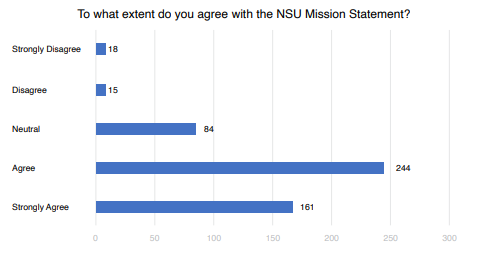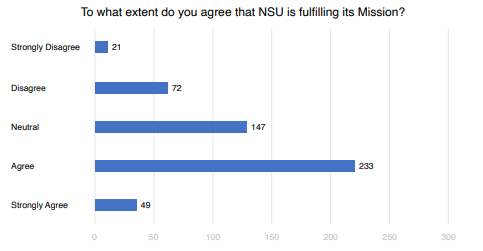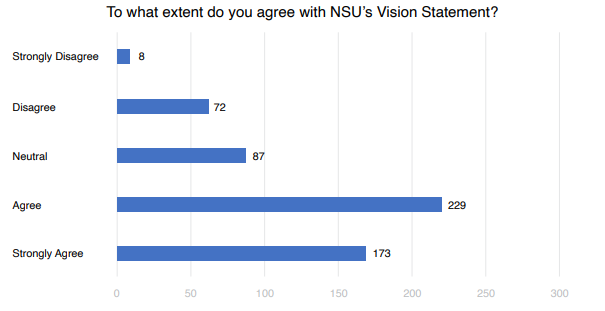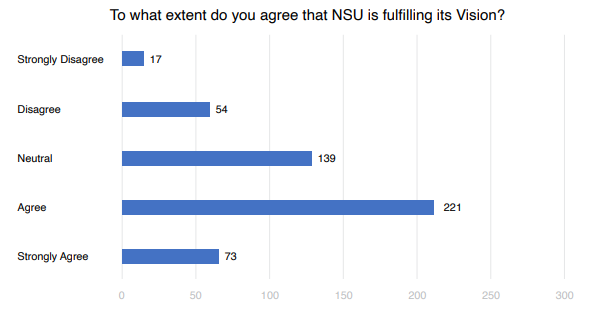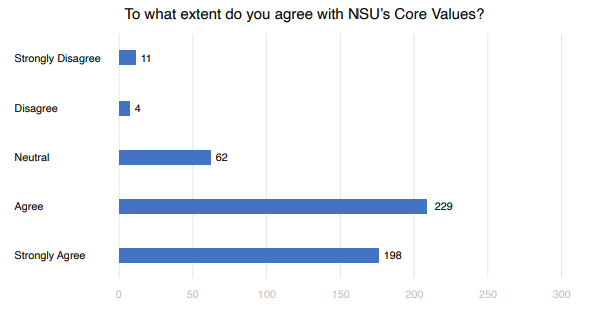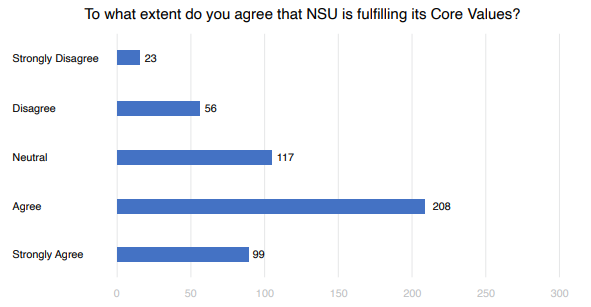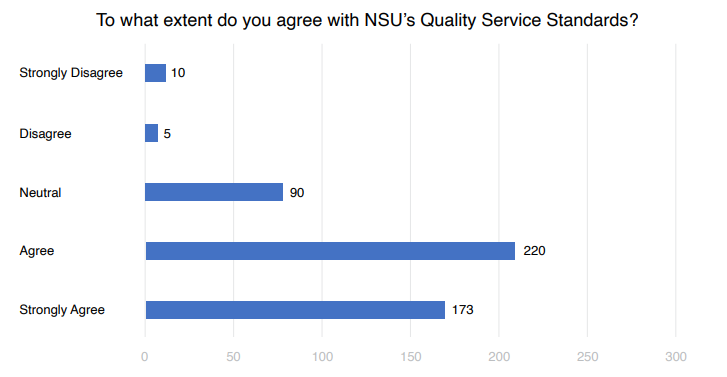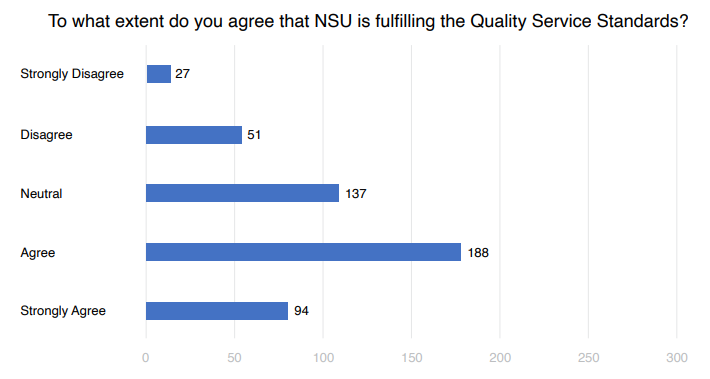Planning Guidelines
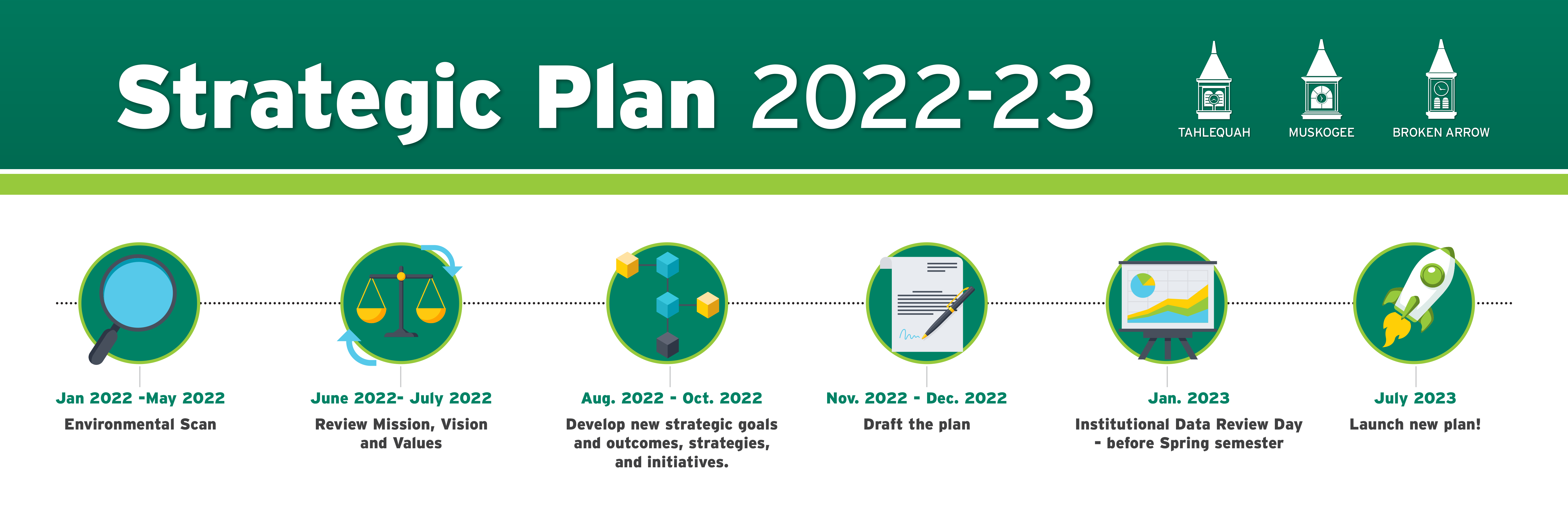
Strategic planning is a systemic process, building commitment to institutional priorities and ensuring that NSU remains vital, sustainable, and accountable. All strategic planning at NSU is founded in the principles of NSU's heritage, mission, vision, values, and strategic goals. All divisions, units and departments should update their strategic plans to align with the NSU plan.
The Strategic Plan Steering Committee is pleased to present the following report and is confident the information will be useful to those guiding the development of the next Northeastern State University Strategic Plan. The Strategic Plan Steering Committee consists of the following members:
Dr. Cari Keller, Chair
Dr. Kim Williams, Academic Affairs
Dr. Kelly Jo Larsen, Student Affairs
Dr. Richard Reif, Administration and Finance
Dr. Peggy Glenn, Foundation and Alumni
Mr. Brian Manley, University Relations
Planning Process
NSU’s current strategic plan, Excellence: The Path to Success, has been the seminal institutional planning document since July 1, 2015. The existing strategic plan, paired with Destination 2023, NSU’S comprehensive institutional guide for enrollment and graduation goals, provides the institutional strategic goals and planning framework to fulfill our mission as a state constitutionally-created, public regional university. Both of these institutional planning documents sunset on June 30, 2023. The NSU Cabinet has charged the Strategic Plan Steering Committee to lead the institutional process to sunset the current NSU Strategic Plan by June 30, 2023, and develop a new Strategic Plan to begin on July 1, 2023.
The SP Steering Committee is composed of members representing each division, and will work with the larger institutional Strategic Planning Committee, NSU faculty and staff, students, and the greater NSU community in developing the new plan. The SP Steering Committee members include Dr. Cari Keller, Chair, Dr. Kim Williams (Academic Affairs), Dr. Kelly Jo Larsen (Student Affairs), Dr. Richard Reif (Administration & Finance), Dr. Peggy Glenn (Foundation & Alumni), and Mr. Brian Manley (University Relations).
To begin the process of developing a new strategic plan, The SP Steering Committee organized a three-part environmental scan consisting of: (1) a university-wide survey with 1,147 responses, (2) 21 university committee focus groups with 180 participants, and (3) three community town halls and a listening session with the NSU Alumni Association Board, in which a total of 49 external stakeholders participated.
The new strategic plan survey explored our stakeholders’ individual perceptions regarding the NSU Mission, Vision, Values, and Quality Service Standards. Additionally, the survey conducted an individual “SWOT” analysis, requesting respondents to list three to five strengths, weaknesses, opportunities, and threats related to NSU. A SWOT analysis was also conducted during the internal committee focus groups and the external town hall sessions. The group SWOT analyses were intended to capture group perceptions based upon the charge of the relevant committee for members of the internal focus groups or upon the organization they represented for the external community town halls. This afforded the opportunity to capture SWOT data from mission-aligned topical perspectives. On March 21, 2022, NSU President Turner publicly detailed the strategic planning process as noted above in an op-ed for the Tahlequah Daily Press.
NSU Strategic Plan Survey Highlights
The survey was the only part of the environmental scan that – because of its longer length – captured our constituents’ perceptions of our guiding purpose statements: our Mission, Vision, Values, and Quality Service Standards. Current students represented more than half of the survey participants (56.1%). These students overwhelmingly agreed or strongly agreed with the language of NSU’s Mission (75.6%), NSU’S Vision (79.1%), the Core Values (82.4%) and the Quality Service Standards (79.9%). Similar agreement was seen among the faculty, staff, and community members who responded. Respondents also agreed that NSU was fulfilling these purpose statements, however, at a lower percentage. For example, students agreed or strongly agreed that NSU was fulfilling its Mission (61.7%), its Vision (63.8%), its Values (67%), and its Quality Service Standards (64%). As before, there was similar agreement among the other populations who responded.
Combined SWOT Analysis Highlights
The SWOT analysis, which was included in the survey, the internal committee focus groups, and the external community town halls, revealed a great deal of consistency among the various groups and survey participants. The following summarizes key data points that were consistently mentioned throughout all parts of the environmental scan:
- NSU is seen as a critical partner in our region, and a significant economic driver.
- NSU’s affordability, the value and reputation of a degree from NSU, the care that our faculty and staff demonstrate to our students, and the availability of online courses to increase access to education were universally mentioned as strengths, whether in the survey, a committee session, or a town hall.
- On the flip side, lack of resources to maintain our facilities and technology, retain a skilled and qualified workforce, and ensure the support of faculty and staff both in and out of the classroom were universally seen as needed areas for improvement.
- Online and flexible course and program delivery, developing strong relationships with workforce partners to be their educational solution, connecting students to their chosen fields of study through immersive and experiential learning opportunities, continuing to develop relationships with our tribal communities, and targeting and retaining new enrollment populations were seen as the prevailing opportunities.
- Lack of fiscal resources, a shrinking traditional college-bound population, increased competition, the workforce, and perceived declining value of a college degree were identified as our most pressing threats.
Recommendations from the Environmental Scan
Upon careful consideration of the survey data and the discussion points made during the internal NSU committee focus groups and external community town hall sessions, the SP Steering Committee makes the following recommendations:
- Recommendation 1: As a state constitutionally-created, regional public university with a rich and unique cultural history serving traditional and non-traditional students, NSU must ensure educational access and support for all student populations, including but not limited to first-time full-time freshmen, transfer students, graduate students, and local businesses with specific workforce needs.
- Recommendation 2: Enhance NSU’s workforce connections by ensuring our students are career ready, that our faculty are engaged with their workforce counterparts, and that we are creating partnerships with tribes and employers in the region to be the educational partner of choice and therefore prove the value of a college degree.
- Recommendation 3: Ensure competitiveness by providing high quality, flexible delivery of courses and degrees, from general education courses to major courses, and from credential courses to graduate courses, in the mode(s) that attract the highest enrollment while providing the resources, technology, professional development, and other tools necessary to do so.
- Recommendation 4: Foster student retention by engaging them in co-curricular and experiential learning opportunities, encouraging genuine concern for students and early intervention by faculty and staff, facilitating student and employee engagement in events and activities on all campuses, and supporting the enhanced use of immersive technology.
- Recommendation 5: Invest in the employees and facilities so that both are performing at their best, excelling at their functions, and are outfitted with the tools and technology needed in today’s intensely competitive workforce and evolving digital environment.
On October 15, 2021, Strategic Planning Steering Committee Chair Dr. Cari Keller reached out to other members of the Steering Committee: Dr. Kimberly Williams (Academic Affairs), Dr. Kelly Jo Larsen (Student Affairs), Dr. Richard Reif (Administration & Finance), Peggy Glenn (Foundation & Alumni), and Brian Manley (University Relations), who had each been nominated by their respective Vice Presidents. Dr. Keller charged the group with “developing the process to wind down the current strategic plan and D23 [Destination 2023: A Roadmap to Distinction, created as part of the Complete College America Program] and the process to develop the new plan.
In preparation for a Cabinet retreat, the Steering Committee met and developed a strategic plan transition proposal that Dr. Keller presented to the Cabinet, which was adopted.
The SP Steering Committee implemented a three-part process to gather input from key stakeholders, including: (1) a widely-distributed online survey, (2) internal university committee focus groups, and (3) external community town hall meetings, as described below.
New Strategic Plan Survey
The survey was designed to solicit independent and individual feedback from both internal and external constituents. The 23-item survey was designed in Survey Monkey, and distributed by email from the NSU President’s Office to students, staff, faculty, administration, current alumni association members (annual and lifetime), and foundation donors of at least $250 per year or at least $750 over the past three years. Responses were collected anonymously. Survey items were developed by the Strategic Plan Steering Committee and approved by Cabinet.
Survey Items by Topic
| Topic | Items | Item Type |
| Demographic Questions | 1-4 | Matrix with defined choices |
| SWOT Analysis | 5-8 | Open ended, Identify 3-5 for each category: Strength, Weakness, Opportunity, Threat |
| Critical Issues | 9 | Open ended, Identify 3-5 critical issues |
| Key Priorities | 10 | Open ended, Identify 3-5 key priorities |
| NSU Mission | 11-13 | 2 Likert scale, 1 open ended |
| NSU Vision | 14-16 | 2 Likert scale, 1 open ended |
| NSU Core Values | 17-19 | 2 Likert scale, 1 open ended |
| NSU Quality Service Standards | 20-22 | 2 Likert scale, 1 open ended |
| Other | 23 | Open ended |
A participation incentive was offered to encourage survey completion. Upon completing the survey, respondents were directed to a Google form where they could enter their name, email, phone number, and whether they were an employee, student, alumnus, or community member. This separate form ensured the anonymity of survey participants. Nine (9) $100 Visa gift cards and ten (10) NSU-branded camping chairs were awarded to randomly drawn participants, divided into the three following groups: employees, students, or alumni/community members.
The survey was open from February 8, 2022 - February 18, 2022. A total of 1,147 survey responses were collected, with approximately half of those providing substantive input. Summary results are presented in the Data Aggregation and Analysis section below.
Internal University Committee Focus Groups
The Strategic Plan Steering Committee utilized standing University committees for focus group populations. The following University committees are mission-aligned and the committee members were given an opportunity to provide individual and group feedback from the perspective represented on each committee. The SP Steering Committee held listening sessions with the standing University committees listed below.
University Committee Focus Groups
Academic Council
American Indian Heritage Committee
Banner Operations Committee
Black Heritage Committee
Ctr for Teaching & Learning Advisory Comm. Diversity, Equity, Inclusion Task Force
Environ. Safety & Sustainability Committee
Faculty Council
Financial Aid Appeals Committee
First year Experience Committee
General Education Committee
Graduate Council
Library Committee
NSU Student Government Association
Retention Committee
Staff Council
Student Affairs Leadership Team
Student Learning & Assessment Committee
University Advising Committee
University Technology Committee
Workforce Development Committee
These committees include staff, faculty, administration, and student members. Where feasible, at least three members from the SP Steering Committee were present. One member led the discussion, and two members took notes. The SP Steering Committee members did not engagein the conversation in an effort to allow an organic and unbiased dialogue among the committee members, except when clarification or additional explanations were necessary. We did not want to lead them to specific responses.
The following questions guided the committee discussions:
- What do you see as the key strengths of NSU?
- What do you see as NSU’s weaknesses/areas of needed improvement?
- What are the critical issues that NSU needs to face over the next three –
five years? - What are the major forces, trends, or issues in higher education, in our
state, our system, and our region - that will affect the future of NSU? - What do you see as the key priorities that NSU should establish in its
strategic plan?
External Community Town Halls
NSU held three community town halls, one for each campus community, and met with the NSU Alumni Association board of directors. For the town halls, community members were invited, with special attention made to include members from each of Oklahoma’s identified Critical Occupation sectors. Email invitations were sent from the NSU President’s Office (see Appendix 9, 10, and 11 for the email template and invitation/attendance lists). President Turner opened each town hall session, establishing the purpose of the sessions and reviewing the existing NSU Strategic Plan. He was not present during the subsequent town hall discussions, which were led by Dr. Cari Keller. Notes were taken by at least four steering committee members. As with the internal committee focus group sessions, the SP Committee members did not participate in the dialogue.
The town halls were held on the following dates:
Tahlequah Community
Muskogee Community
Broken Arrow Community
NSU Alumni Association Board Meeting
March 3, 2022
March 8, 2022
February 28, 2022
March 5, 2022
The following questions led the discussion at each town hall:
- What are our areas of greatest strength and promise? What makes NSU unique?
- What are NSU’s weaknesses? What are areas that you believe could be strengths with
some modifications? What modifications do you believe are
needed? - What are the major forces, trends, or issues in higher education, in our state, our system, and our region - that will affect the future of NSU?
- What do you see as the key priorities that NSU should establish over the next 5 years?
- How does NSU become the educational partner of choice for our community partners?
Answers to open-ended questions from the survey were downloaded into Excel. The internal committee focus group notes and the external town hall notes were reviewed and aggregated into one set, and transferred into Excel (see Appendix 8 and 12). NVivo software was used to review and code the data.
Survey Participants
Survey Participants by Primary Role
A total of 1,147 participants submitted the survey. Current students accounted for a majority of the responses (56.06%), followed by staff (18.05%), faculty (15.17%), and alumni (10.37%). Only 0.35% of the participants identified as community members.
| Primary Role at NSU | Responses | Response % |
| Current Student | 643 | 56.06% |
| Alumni | 119 | 10.37% |
| Faculty | 174 | 15.17% |
| Staff | 207 | 18.05% |
| Community Member | 4 | 0.35% |
Student Responses by Classification
Students from all classifications were represented. The largest student group to participate in the survey was Seniors (32.71%), followed by Juniors (22.90%), Graduate Students, including master’s level and Optometry students (20.72%), Freshmen (12.62%), and Sophomores (11.06%).
| Student Classification | Responses | Response % |
| Freshman | 81 | 12.62% |
| Sophomore | 71 | 11.06% |
| Junior | 147 | 22.90% |
| Senior | 210 | 32.71% |
| Graduate Student | 133 | 20.75% |
Primary Campus
Most participants indicated Tahlequah as their primary campus (62.83%), followed by Broken Arrow (19.86%) and Muskogee (4.23%). There was also representation from online programs (11.11%).
| Campus | Responses | Response % |
| Tahlequah | 639 | 62.83% |
| Muskogee | 43 | 4.23% |
| Broken Arrow | 202 | 19.86% |
| Online | 113 | 11.11% |
| Assigned to all Campuses | 20 | 1.97% |
NSU’s Mission Statement
Survey participants were directed to NSU’s Mission, Vision and Values webpage to review the mission statement, developed by NSU’s Strategic Planning Committee for 2015-2023 (see Appendix 5).
Focused Mission Statement:
We empower students, faculty, staff and the community to reach their full intellectual and human potential by creating and expanding a culture of learning, discovery, and diversity.
Participants were asked (1) if they agreed with the mission, and (2) if NSU is fulfilling
its mission. A total of 522 survey participants answered both questions. There is
widespread agreement with the NSU Mission Statement with 77.6 % agreeing (46.7%) or
strongly agreeing (30.8%). Few participants, only 6.3%, disagree (2.9%) or strongly
disagree (3.4%) with the NSU Mission.
More than half, 54%, agree (44.6%) or strongly agree (9.4%) that NSU is fulfilling
its mission. However, a greater percentage, 17.8%, disagree (13.8%) or strongly disagree
(4.0%) that NSU is fulfilling its mission. These results did not vary significantly
based on the participant’s primary role (see Appendix 6 for responses by role).
NSU’s Vision Statement
Survey participants were directed to NSU’s Mission, Vision and Values webpage to review the vision statement, developed by NSU’s Strategic Planning Committee for 2015-2023.
Northeastern State University shapes the future of its region as the educational partner of choice, setting a standard of excellence by serving the intellectual, cultural, social and economic needs of the University’s diverse communities.
Participants were asked (1) if they agree with the NSU Vision Statement, and (2) if NSU is fulfilling its Vision. A total of 508 participants responded to the agreement question, and 504 participants responded to the fulfillment question.
As with the Mission Statement, a significant majority of participants, 79.1%, agree (45.08%) or strongly agree (34.06%) with NSU’s Vision Statement. Only 15.74% of the participants disagree (14.17%) or strongly disagree (1.57) with the Vision Statement. A majority, 58.3%, also believe that NSU is fulfilling its vision, with 43.9% agreeing and 14.5% strongly agreeing. Only 14.08% disagree (10.71%) or strongly disagree (3.37%). These results did not vary significantly based on the participant’s primary role.
NSU’s Core Values
Survey participants were again directed to NSU’s Mission, Vision and Values webpage. On that page, NSU’s core values, developed by NSU’s Strategic Planning Committee for 2015-2023, are as follows:
Integrity
Collaboration
Creativity
Leadership
Excellence
Communication
Diversity
Participants were asked (1) if they agreed with the Core Values, and (2) if NSU is fulfilling these Core Values. A total of 504 participants responded to both questions. When asked to what extent they agree with NSU’s core values, 84.7% agree (45.4%) or strongly agree (39.3%). Notably, only 2.97% of the 504 participants disagree or strongly disagree with NSU’s core values When asked to what extent survey participants agree that NSU is fulfilling its core values, 61.03% of the 503 participants agree (41.35%) or strongly agree (19.68%). Only 15.7% of participants disagree (11.13%) or strongly disagree (4.57%).
NSU’s Quality Service Standards
Survey participants were directed to NSU’s quality service standards webpage. Developed by NSU Staff and Faculty in 2015, these quality service standards are further illustrated by “I care therefore I will” statements:
CARE
SAFETY
TIMELINESS
CONSISTENCY
A total of 498 participants responded to (1) whether they agree with the QSS, and (2) a total of 497 responded to whether they agree that NSU is fulfilling the QSS. A total of 78.9% agree (44.2%) or strongly agree (34.7%) with NSU’s quality service standards. Only 3% disagree or strongly disagree with these standards. A total of 56.7% participants agree (37.8%) or strongly agree (18.9%) that NSU is fulfilling these standards. Similar to the previous questions, 15.69% of the participants disagree (10.26%) or strongly disagree (5.43%).
The survey data from the open-ended questions from the New Strategic Plan Survey, Internal NSU Committee Focus Group Sessions, and External Community Town Halls were coded using NVivo software. The top five themes for strengths, weaknesses, opportunities, and threats for each are presented below.
New Strategic Plan Survey
New Strategic Plan SWOT Top 5
1. Classes (size, offerings, schedule)
2. Faculty (dedication & support)
3. Student Support (advising, tutoring, career, library, tech)
4. Campus environment
5. Out of the classroom opportunities (engagement &
co-curricular)
1. Student Support (branch campuses, nontraditional, transfers)
2. Faculty and staff (pay, work load, retention)
3. Facilities (dining, housing, accessibility, tech)
4. Parking (availability, cost)
5. Programs (meeting workforce needs, student support for all populations, resources
to grow as needed)
1. Academic programs (career readiness, meeting new workforce needs, fostering new
partnerships, flexible course delivery, course quality)
2. Student support (academic, career, and online support)
3. Student recruitment
4. Telling NSU’s story (branding, communication)
5. Branch campuses (additional programs and partnerships)
1. Competition (other institutions, higher-paying entry-level jobs)
2. Public funding
3. Employee retention
4. Perceived value of a degree
5. Student needs & expectations (mental health, flexible course delivery, college
readiness)
1. Student support & retention
2. Academic quality & access to education through flexible delivery
3. Employee support, development, and retention
4. Facilities & technology improvements
5. Student recruitment (both traditional and nontraditional)
Strengths
Please describe 3-5 things that NSU does well, or things that you feel are a strength of NSU.
Survey participants consistently included small class size as an institutional strength,
along with course offerings, online courses, and course scheduling. Faculty dedication,
mentorship and support, and knowledge were noted strengths for our faculty. Participants
mentioned student support in many forms, including academic support and advising,
career support, the library, tech support and student transitions. Participants cited
the beautiful setting of our campus, the
safe and welcoming environment, and the fact that we have multiple campuses. Student
engagement and activities on campus, as well as student organizations, are seen as
valuable strengths. Academic programs, friendly and helpful staff, and our student
populations are additional noted strengths.
Weaknesses
Please describe 3-5 things that NSU needs to improve upon, or things that you feel are a weakness of NSU.
While student support fell within the top five most cited strengths, many also noted the challenges presented in supporting diverse student populations on multiple campuses. Low pay, increasing workforce competition, work load, retention, and support were discussed in relation to faculty and staff. Facilities concerns included dining, housing, accessibility, lighting and technology. Participants, largely students, cited parking, including cost of parking and its availability, as an area for improvement. Perceived weaknesses in our program offerings were shared with some consistency. These reflections centered on ensuring programming meets workforce needs, increasing the graduate program offerings, ensuring student support for all student populations, and ensuring programs have resources to grow.
Opportunities
Please describe 3-5 opportunities that NSU should consider to be successful moving forward.
The academic programs theme focused on ensuring career readiness within existing programs, adding new programs to meet workforce needs, fostering new community partner connections, flexible course delivery, and course quality. Consistent with other commentary on student support, participants mentioned the opportunity to focus on academic, career, and online support.
Threats
Please describe 3-5 external threats to NSU’s success.
Increasing competition from other colleges and universities, economic incentives to enter the workforce without a college degree, declining funding, and employee retention were touched upon in a majority of the responses. Additionally, several survey participants commented on the threat presented to our future students from the lingering impact of COVID and the economy, such as mental health pressures, student expectations for flexible delivery to accommodate other life responsibilities, and college readiness. These concerns were shared in the focus group and town hall sessions as well.
Key Priorities
What are the key priorities that NSU should establish in its next strategic plan?
Not surprisingly, participants overwhelmingly mentioned that student support and development, as well as ensuring quality academic programs and access to educational credentials through flexible delivery as the most important institutional priorities. Faculty and staff support, development, and retention are vital to any initiatives targeting student success and quality programming, and participants regularly commented on this area as a key priority. Facilities and technology improvements across all three campuses were frequently mentioned. Student recruitment rounded out the top five, focusing on our traditional student population as well as additional recruitment support for non-traditional populations.
Internal University Committee Focus Groups
Internal Committee Focus Groups SWOT Top 5
1. Students (overall experience)
2. Campus (cultural heritage)
3. Faculty and Staff (dedication,
quality, concern for students)
4. Workforce (support of needs,
geographic reach)
5. Academic Programs/ Affordability/Class Delivery were tied
1. Employee Retention (loss of institutional knowledge, cost of rehiring & training)
2. Student Concerns (Covid impact, decentralized support, focus on FTFTF)
3. Technology (staying current)
4. Facilities (deferred maintenance)
5. Declining Budgets
1. Competition and online
education (online & flexible
course delivery)
2. Workforce (low unemployment, deferring college for jobs)
3. Perceived Value (of college degree)
4. Identity (differentiation
based on our value & place)
5. Higher Education Funding
1. Technology (administrative
& academic)
2. Enrollment Targets (focus
beyond FTFTF)
3. Job Market (workforce, Hispanic, tribal)
4. Online Education (flexibility to offer hybrid & online)
5. Connecting Student to Workforce (experiential,
immersive opportunities)
1. Student Support and
Engagement (post-Covid)
2. Identity and degree
programs (staying mission focused)
3. Faculty and staff retention and support
4. Recruitment (shrinking pool
of HS grads)
5. Facilities and Infrastructure
Strengths
What do you see as the key strengths of NSU?
The committees recognized the passion and dedication of the NSU faculty and staff. Particular recognition was given to the strong relationships with students, and the quality of instruction. A recurring comment in many committees described a high level of care and concern demonstrated, and the sense of community that staff and faculty build with students and each other. Participants across committees consistently referred to the strength of the overall student experience, and our connection to our Native American heritage and communities. Many participants mentioned NSU’s willingness to support the needs of our workforce and the geographic reach that multiple campuses offer. Participants consistently referenced the comprehensive academic programming offered, along with the institutional effort to ensure continuous quality and improvement in our academic offerings.
Weaknesses
What do you see as NSU’s weaknesses/areas of needed improvement?
The most frequently discussed area of improvement involved employee retention and
support. The loss of institutional knowledge, subject matter experts (both faculty
and staff), and the time and resources involved in hiring, onboarding, and training
new employees weighed heavily in all committee discussions. Declining budgets, state
support, maintaining current technology, and facilities issues were closely related
to concerns over employee retention. Participants in several committees reflected
on the strength of our academic programs, particularly in relation to meeting our
workforce demands and their need to continuously upskill employees. However,
our employee retention issues along with perceived barriers to nimbleness were seen
as a significant weakness in perpetuating this strength. Student concerns largely
related to lingering effects of Covid, a decentralized student support system for
tutoring and resources, and the perception that many support systems are built for
the traditional first-time freshman, but the majority of our student population fall
outside of these parameters and need more flexibility in student support services.
Major Trends
What are the major forces, trends, or issues in higher education, in our state, our system, and our region - that will affect the future of NSU?
There was widespread discussion about online and flexible course delivery and the impact it hason increased competition among colleges and universities. Additionally, the low unemployment rate and competitive workforce environment is attracting current and potential students directly into the job market. The discussions noted the importance of mission centrality and identity in articulating NSU’s value and place among competitors. Flexibility and “nimbleness” were terms consistently used by committee members.
Critical Issues
What are the critical issues that NSU needs to face over the next three – five years?
Each of the top five critical issues included a reference to the importance of employee
retention and support. The discussions focused on maintaining and improving technology
to remain competitive, including both administrative and academic technology. Faculty,
staff, and students alike consistently expressed the importance of immersive/experiential
opportunities to student success. The conversations surrounding online education focused
on supporting faculty and students. There was a general consensus among committee
participants that flexible course offerings utilizing online and hybrid delivery methods
are necessary to be competitive. However, there was equal concern and caution related
to the impact this will have on our university identity and the integrity and quality
of programming. Additionally, committee members discussed a need to focus enrollment
targets beyond first-time freshmen, including transfer students, workforce populations,
and expanding our relationships with the Hispanic and tribal communities.
Key Priorities
What do you see as the key priorities that NSU should establish in its strategic plan?
The key priority conversations centered on continuing an excellence mindset in all
things
we do. To do so, committee members encouraged continued focus on student support and
engagement. Covid and the advancements made in flexible course delivery created additional
support and engagement challenges. Discussions relating to recruitment were frequently
associated with the shrinking traditional college-bound high school populations. Many
participants centered their discussion around NSU’s identity. As a comprehensive regional
institution in a competitive economic market, how do we stay mission focused? Several
discussions linked our focus on immersive/experiential learning directly to our identity.
External Community Town Halls
Town Hall SWOT Top 5
1. Community Engagement (teacher development during Covid, relationship to tribes)
2. Culture and history
3. Faculty, staff, administration
4. Affordability
5. Access (for students, for
community leaders to seek subject matter experts & collaboration)
1. Branch Campuses (4-year
offerings)
2. Community Engagement (cultural, social, & entertainment events on branch campuses;
consistent connection point)
3. Degree Programs (expanding
programs offered)
4. Identity (what are we known for, all things to all people)
5. Athletics (involving branch campuses, having competitive teams in MIAA)
1. Funding and perceived value of degree
2. Branch campuses (losing local students because no 4-year option)
3. Students (shrinking number of HS grads, adjust to future students’ needs)
4. Online Education (impacts TAH campus most, with students no longer needing to live
on campus)
5. Degree programs to meet workforce needs
(Answers were same as major
trends)
1. Funding and perceived value
2. Branch campuses
3. Student Recruitment
4. Online Education
5. Degree programs to meet workforce needs
1. Workforce (collaboration &
development with employers)
2. Branch campuses (prefer 4-year degrees on campus, offer
degree completion for workforce)
3. Community and student connection (immersive &
experiential opportunities)
4. Identity (who do we serve and how)
5. Communication (sharing updates with local communities & employers)
Strengths
What are our areas of greatest strength and promise? What makes NSU unique?
Community members ranked NSU’s connection to the community as a top strength, particularly
in Muskogee and Broken Arrow. Community members in more than one town hall referenced
the College of Education’s leadership, faculty mentorship, and coaching for K-12 school
teachers as they made the transition from in-school to distance learning as a prime
example. NSU’s relationships with the Cherokee Nation, United Keetoowah Band, and
Muscogee Nation and unique cultural opportunities were frequently mentioned. Our communities
recognized the value of our comprehensive academic offerings, and the significance
of efforts to remain an affordable educational choice. Many constituents commented
favorably regarding the availability of online courses and programs. Three campuses
provide students and community stakeholders with multiple access points. In addition
to an educational location, the campuses provide community leaders with close access
to subject matter experts and opportunities for collaboration.
Weaknesses
What are NSU’s weaknesses? What are areas that you believe could be strengths with some modifications? What modifications do you believe are needed?
Interestingly, several themes identified as strengths also surfaced as weaknesses
as community members engaged with one another. The branch campus community members
expressed a strong desire for four-year degree programs on these campuses. A majority
of community members articulated the difficulty that many student populations have
in driving to Tahlequah to complete general education courses or classes in their
major that may not be offered on one of
the branch campuses. Additionally, they spoke of the prestige and economic impact
that having a four-year campus would have for their communities. The branch campus
community members also encouraged more cultural, social, athletics, and entertainment
events on the branch campuses. Community engagement was seen as a great strength,
and also a vulnerability, because individuals in an institution leave or move positions,
continuity of connection and engagement may be difficult to sustain. All three communities,
the Tahlequah healthcare
community most strongly, articulated that a more intentional connection should exist
between community leadership, businesses, and academic programs, reinforcing the importance
of immersive/experiential opportunities and the role of our subject matter experts
in community building. All three communities expressed their concern regarding identity,
specifically the difficulty of being “all things to all people.” They noted that we
used to be known as the “teacher’s college” but what are we known for now?
Critical Issues
What are the major forces, trends, or issues in higher education, in our state, our system, and ourregion - that will affect the future of NSU?
Community members recognized declining state funding and rising costs as one of the most important issues facing institutions of higher education. Community leaders from our branch campuses also voiced continued concerns about the lack of the true local four-year degree from the standpoint of keeping talent within their communities. They expressed that once students leave for college, it is difficult to attract them back. The participants discussed the shrinking college-bound population, coupled with workforce pressures, and the impact of Covid on student recruitment and retention. The future student population will look very different from the current population. Community members viewed online education as both a strength and a threat to the Tahlequah campus particularly. They overwhelmingly emphasized the need to maintain strong relationships between degree programs and their workforce populations.
Key Priorities
What do you see as the key priorities that NSU should establish over the next 5 years? How does NSU become the educational partner of choice for our community stakeholders?
The community members on all three campuses articulated some aspect of workforce development and collaboration as their foremost-mentioned priority. The branch campuses reiterated that – not only would a four-year degree be preferable on the local campus – but programs need to be offered for degree completion that support the needs of the local workforce. Additionally, immersive/experiential opportunities were seen as a priority.
The data presented in this report represents a holistic review of NSU through the eyes of our students, both current and alumni, our faculty and staff, and the communities that we represent. To summarize, our constituents overwhelmingly agree in the language, purpose, and direction of our NSU Mission, Vision, Value, and Quality Service Standards. And, the majority agrees that we are fulfilling those statements. From the SWOT analysis we find a consensus among our stakeholder populations that we are a vital community partner and economic driver for our region. Our faculty and staff positively impact our students’ lives on a daily basis and shape them into the citizens of our communities’ future. The purpose of any environmental scan is to identify those critical areas where we must adapt to continue our mission and vision of excellence, as noted in the five recommendations in the Executive Summary above. This Strategic Plan Steering Committee hopes that this report and the underlying data will be used by campus teams to identify NSU’s next key priorities and strategic goals, steps, resources, and processes to excel as the educational partner of choice.

